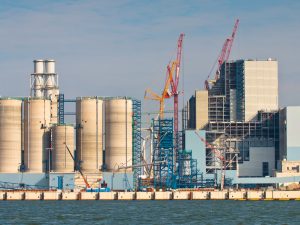In April 2021, Chinese President Xi Jinping told a Leader’s Summit on Climate that “China will strictly control coal-fired power generation projects, and strictly limit the increase in coal consumption over the 14th Five-Year Plan period [2021-2025] and phase it down in the 15th Five-Year Plan period [2026-2030].”
This year, Xi is eating those words.
Five-year plans are the foundational guidelines that map out economic goals, development policies, and overall reforms for China for every five-year period. They have determined the direction of China’s development since 1953.
However, in the case of coal and coal-fired power plants, China has had to reverse its stated course just over a year into the 14th Five-Year Plan, into which Xi Jinping himself is said to have had detailed input.
Han Wenxiu, deputy director of the Office of the Central Finance and Economic Commission, said that Xi had hosted several high-level meetings in the draft phase of the plan, and that Xi “multiple times personally made changes and approved the draft and has put in a tremendous amount of energy on it.”
So, it’s an inescapable conclusion that Xi knows that he over-promised in 2021 regarding the prospects of weaning China off coal.
Indeed, in April of this year, contrary to Xi’s April 2021 pronouncement that China would “strictly limit the increase in coal consumption over the 14th Five-Year Plan period,” China announced that it was adding an extra 300 million tons of coal mining capacity to its already world-record holding production levels. China is not only the largest consumer of coal in the world, it is also the largest producer of coal, as well, mining over 4 billion tons of coal in 2021.
Not only has coal mining capacity surged this year, but China has also approved the addition of 8.63 gigawatts (GW) of new coal-fired power plants just from January through March of 2022, research from Greenpeace’s Beijing office found.
That additional capacity, in just over three months, is equal to almost half – 46 percent – of the total additional capacity approved in all of 2021, according to the environmental organization.
As Wu Jinghan, a climate and energy campaigner in Greenpeace East Asia’s Beijing office, wrote in a commentary for The Diplomat, the surge in coal was tied to a new wave of rhetoric emphasizing energy security. “Energy security has become sort of a code word for coal, rather than for reliable supply of energy.” Ironically, Wu wrote, China’s “energy crisis arose in part because of China’s reliance on coal. Nonetheless, official messaging around ‘energy security’ skyrocketed… it appears that the coal industry is again moving ahead at full steam.”
Much of the world was pleasantly surprised and even excited when China announced in September 2021 that it would stop financing coal-fired power plants outside of China.
Before reading too much altruism into that policy, however, interested parties might do well to read the rest of the 14th Five-Year Plan that describes China’s development impetus until 2025. The South China Morning Post succinctly summarized the overall theme of China’s current plan with its October 30, 2020 headline, “China Moves to Technology Self-Sufficiency.”
Self-sufficiency, indeed a form of economic isolationism, is from China’s perspective the only safe and secure path to achieving its next set of development targets. For example, China hopes to build sophisticated semiconductor factories to supplant its dependence on foreign sources – especially since Beijing has political problems with many of these suppliers, such as the United States and Taiwan.
But how to power that additional technological capacity? China has the coal, and they have the will to build coal-fired power plants to use it.
China’s 14th Five-Year Plan mentions coal 23 times. Many of those instances indicate expansion, increase, and ease of access. “We will promote the expansion of the coal transportation capacity of Caofeidian Port,” “promote the flexible refitting of coal-fired power plants,” and “improve cross-regional transportation channels and collection and distribution systems for coal” are but three examples. The “intelligent upgrading” of coal mines will be promoted, the plan says.
In less developed regions, including Xinjiang, which has caused China enormous reputational damage in recent years due to its policies of forced internment and re-education of the Uyghur and other Muslim minorities, the plan supports “Xinjiang’s construction of the national ‘three bases and one channel’” project, which refers to the construction of “a large-scale coal, coal-fired electricity, and coalification industry base,” among other energy facilities, mostly non-renewables.
Compared to coal, the 14th Five-Year Plan mentions “technology” 69 times, “technological” 25 times, and the S&T abbreviation for Science & Technology a whopping 79 times. On a purely empirical basis, it’s clear where China’s emphasis lies.
Like politicians even in democracies, the Chinese leadership will make bold statements for convenient political reasons pertinent to the time. (They generally are a little more careful than Western politicos, however. Democracies retire their politicians, usually, at the ballot box. Autocracies tend to use purges.) Earlier pronouncements that led to exaggerated commitments to cut coal usage and work toward emissions reductions can be seen as attempts to mollify in the moment the international and domestic critics of China’s coal use.
It goes without saying that authors of the plan knew where the emphasis was all along, and that it wasn’t on cutting coal usage, which will power the primary agenda of the plan: technological superiority, self-sufficiency, security, and most of all from the Chinese point of view, stability.
Even China’s commitment to end funding for overseas power plants possibly contains an ulterior motive. For every coal-fired power plant not built in another country, that’s a lot of coal that can go elsewhere. China burns more coal than the rest of the world combined, and that’s a trend only likely to increase. Every extra little bit helps.

































